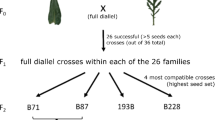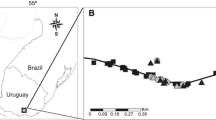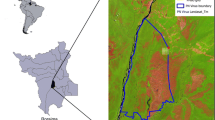Abstract
Chemical surface characters play a decisive role in the interaction between plants and their environment. Maternal or paternal inheritance of wax characters in Rosa, section Caninae may allow for ecological niche differentiation according to the parental evolutionary constraints. If so, the radiation of hybrid offspring may reflect the parentally determined framework of interaction and selection against pathogens and abiotic stresses. We tested the inheritance of cuticular chemical wax parameters of reciprocal hybrids within Rosa, section Caninae, the dogroses. We not only found an extremely rich spectrum of chemical compounds on abaxial and adaxial leaf surfaces of dogroses, but also a maternally skewed inheritance of some of these wax characters. The possible role of these findings for the evolution of the allopolyploid dogrose complex is discussed.
Similar content being viewed by others
References
E. A. Baker (1982) Chemistry and morphology of plant epicuticular waxes D. F. Cutler K. L. Alvin C. E. Price (Eds) The plant cuticle Academic Press London 139–166
W. Barthlott I. Theisen T. Borsch C. Neinhuis (2003) Epicuticular waxes and vascular plant systematics: integrating micromorphological and chemical data T. F. Stuessy V. Meyer E. Hörandl (Eds) Deep morphology. Toward a renaissance of morphology in plant systematics Ganter Verlag Ruggell 189–206
W. Barthlott C. Neinhuis D. Cutler F. Ditsch I. Meusel I. Theisen H. Wilhelmi (1998) ArticleTitleClassification and terminology of plant epicuticular waxes Bot. J. Linn. Soc. 126 237–260 Occurrence Handle10.1006/bojl.1997.0137
W. Barthlott C. Neinhuis R. Jetter T. Bourauel M Riederer (1996) ArticleTitleWaterlily, poppy, or sycamore: on the systematic position of Nelumbo Flora. 191 169–174
K. Blackburn J. W. H. Harrison (1921) ArticleTitleThe status of the british rose forms as determined by their cytological behaviour Ann. Bot. 35 IssueID138 159–188
A. Buske J. Schmidt P. Hoffmann (2002) ArticleTitleChemotaxonomy of the tribe Antidesmeae (Euphorbiaceae): antidesmone and related compounds Phytochemistry 60 489–496 Occurrence Handle12052515 Occurrence Handle10.1016/S0031-9422(02)00117-6 Occurrence Handle1:CAS:528:DC%2BD38XktFOms7c%3D
D. E. Cervantes S. D. Eigenbrode H.-J. Ding N. A. Bosque-Pérez (2002) ArticleTitleOviposition responses by Hessian fly, Mayetiola destructor, to wheats varying in surface waxes J. Chem. Ecol. 28 IssueID1 193–210 Occurrence Handle11868674 Occurrence Handle10.1023/A:1013527205761 Occurrence Handle1:CAS:528:DC%2BD38XhtlWksr4%3D
H. E. M. Dobson J. Bergström G. Bergström I. Groth (1987) ArticleTitlePollen and flower volatiles in two Rosa species Phytochemistry 26 3171–3173 Occurrence Handle10.1016/S0031-9422(00)82464-4 Occurrence Handle1:CAS:528:DyaL1cXptFKquw%3D%3D
S. D. Eigenbrode (2004) ArticleTitleThe effects of plant epicuticular waxy blooms on attachment and effectiveness of predatory insects Arthropod Structure & Development 33 91–102 Occurrence Handle10.1016/j.asd.2003.11.004
N. C. Ellstrand R. Whitkus L. Rieseberg (1996) ArticleTitleDistribution of spontaneous plant hybrids Proc. Natl. Acad. Sci. USA 93 5090–5093 Occurrence Handle11607681 Occurrence Handle10.1073/pnas.93.10.5090 Occurrence Handle1:CAS:528:DyaK28XjtVKlur8%3D
H. J. Ensikat C. Neinhuis W. Barthlott (2000) ArticleTitleDirect access to plant epicuticular wax crystals by a new mechanical isolation method Int. J. Pl. Sci. 161 143–148 Occurrence Handle10.1086/314234
W. Federle U. Maschwitz B. Fiala M. Riederer B. Hölldobler (1997) ArticleTitleSlippery ant-plants and skilful climbers: selection and protection of specific ant partners by epicuticular wax blooms in Macaranga (Euphorbiaceae) Oecologia 112 217–224 Occurrence Handle10.1007/s004420050303
Y. Hashidoko K. Endoh T. Kudo S. Tahara (2000) ArticleTitle(+)-4-epi-á-Bisabolol as a major Sesquiterpene constituent in the leaves of two Rosa rugosa hybrids, Martin Frobisher and Vanguard Biosci. Biotechnol. Biochem. 65 907–910 Occurrence Handle10.1271/bbb.64.907
Y. Hashidoko K. Endoh T. Kudo S. Tahara (2001) ArticleTitleCapability of wild Rosa rugosa and its varieties and hybrids to produce sesquiterpene components in leaf glandular trichomes Biosci. Biotechnol. Biochem. 65 2037–2043 Occurrence Handle11676018 Occurrence Handle10.1271/bbb.65.2037 Occurrence Handle1:CAS:528:DC%2BD3MXnsVyqsbo%3D
Y. Hashidoko S. Tahara J. Mizutani (1989) ArticleTitleAntimicrobial sesquiterpene from damaged Rosa rugosa leaves Phytochemistry 28 425–430 Occurrence Handle10.1016/0031-9422(89)80026-3 Occurrence Handle1:CAS:528:DyaL1MXktlKlsrY%3D
Hashidoko Y., Tahara S., Mizutani J. (1992a) Long chain alkyl esters of 4´ -hydroycinnamic acids from leaves of Rosa rugosa. Phytochemistry 31: 3282–3283.
Hashidoko Y., Tahara S., Mizutani J. (1992b) Rugosal A and related carotane sesquiterpenes in the glandular trichome exudate of Rosa rugosa. Phytochemistry 31: 779–782.
Y. Hashidoko (1996) ArticleTitleThe phytochemistry of Rosa rugosa Phytochemistry 43 535–549 Occurrence Handle10.1016/0031-9422(96)00287-7 Occurrence Handle1:CAS:528:DyaK28XlvF2hsrk%3D
P. J. Holloway C. E. Jeffree E. A. Baker (1976) ArticleTitleStructural determination of secondary alcohols from plant epicuticular waxes Phytochemistry 15 1768–1770 Occurrence Handle10.1016/S0031-9422(00)97477-6 Occurrence Handle1:CAS:528:DyaE2sXmslOjtg%3D%3D
C. E. Jeffree E. A. Baker P. J. Holloway (1975) ArticleTitleUltrastructure and recrystallisation of plant epicuticular waxes New Phytologist 75 539–549 Occurrence Handle10.1111/j.1469-8137.1975.tb01417.x
S. R. Jensen H. Franzyk E. Wallander (2002) ArticleTitleChemotaxonomy of the Oleaceae: iridoids as taxonomic markers Phytochemistry 60 213–231 Occurrence Handle12031440 Occurrence Handle10.1016/S0031-9422(02)00102-4 Occurrence Handle1:CAS:528:DC%2BD38XjvVaktb0%3D
R. Jetter M. Riederer (1994) ArticleTitleEpicuticular crystals of nonacosan-10-ol: In-vitro reconstitution and factors influencing crystal habits Planta 195 257–270 Occurrence Handle10.1007/BF00199686 Occurrence Handle1:CAS:528:DyaK2MXisFOhs70%3D
R. Jetter S. Schäffer M. Riederer (2000) ArticleTitleLeaf cuticular waxes are arranged in chemically and mechanically distinct layers: evidence from Prunus laurocerasus L Plant, Cell and Environment 23 619–628 Occurrence Handle10.1046/j.1365-3040.2000.00581.x Occurrence Handle1:CAS:528:DC%2BD3cXltFWit70%3D
T. Mayer-Kuckuck (1989) Der gebrochene Spiegel. Symmetrie, Symmetriebrechung und Ordnung in der Natur Birkhäuser Basel
K. Mladenova B. Stoianova-Ivanova Y. Anguelova (1980) ArticleTitleInterrelationship between long-chain aldehydes and trialkyltrioxanes in plant waxes Rivista Italiana E.P.P.O.S. 62 133–135 Occurrence Handle1:CAS:528:DyaL3cXlt1ykt7c%3D
K. Mladenova B. Stoianova-Ivanova R. M. Daskalov (1976) ArticleTitleTrialkyltrioxanes in flower wax of some decorative roses Phytochemistry 15 419–420 Occurrence Handle10.1016/S0031-9422(00)86836-3 Occurrence Handle1:CAS:528:DyaE28XhslKktrs%3D
S. Mongrand A. Badoc B. Patouille C. Lacomblez M. Chavent J.-J. Bessoule (2005) ArticleTitleChemotaxonomy of the Rubiaceae family based on leaf fatty acid composition Phytochemistry 66 549–559 Occurrence Handle15721947 Occurrence Handle10.1016/j.phytochem.2004.12.021 Occurrence Handle1:CAS:528:DC%2BD2MXhsVyksLs%3D
S. Mongrand A. Badoc B. Patouille C. Lacomblez M. Chavent C. Cassagne J.-J. Bessoule (2001) ArticleTitleTaxonomy of gymnospermae: multivariate analyses of leaf fatty acid composition Phytochemistry 58 101–115 Occurrence Handle11524119 Occurrence Handle10.1016/S0031-9422(01)00139-X Occurrence Handle1:CAS:528:DC%2BD3MXmt1yjsb0%3D
G. K. Podila L. M. Rogers P. E. Kolattukudy (1993) ArticleTitleChemical signals from Avocado surface wax trigger germination and appressorium formation in Colletotrichum gloeosporioides Pl. Phys. 103 267–272 Occurrence Handle1:CAS:528:DyaK2cXkvVym
M. Riedel A. Eichner R. Jetter (2003) ArticleTitleSlippery surfaces of carnivorous plants: composition of epicuticular wax crystals in Nepenthes alata Blanco pitchers Planta 218 87–97 Occurrence Handle12883887 Occurrence Handle10.1007/s00425-003-1075-7 Occurrence Handle1:CAS:528:DC%2BD3sXovV2lt7c%3D
M. Riederer (1989) The cuticles of conifers: structure, composition and transport properties E. D. Schulze O. L. Lange R. Oren (Eds) Ecological Studies 77 Springer Berlin Heidelberg New York 157–192
L. H. Rieseberg N. C. Ellstrand (1993) ArticleTitleWhat can molecular and morphological markers tell us about plant hybridization? Crit. Rev. Pl. Sci. 12 IssueID3 213–241 Occurrence Handle1:CAS:528:DyaK3sXmt1Wms7Y%3D
C. M. Ritz V. Wissemann (2003) ArticleTitleMale correlated non-matroclinal character inheritance in reciprocal hybrids of Rosa, section Caninae (DC) Ser. (Rosaceae) Pl. Syst. Evol. 241 213–221 Occurrence Handle10.1007/s00606-003-0058-2
C. M. Ritz H. Schmuths V. Wissemann (2005) ArticleTitleEvolution by reticulation: European dogroses originated by multiple hybridization across the genus Rosa J. Heredity 96 IssueID1 4–14 Occurrence Handle10.1093/jhered/esi011 Occurrence Handle1:CAS:528:DC%2BD2MXkt1aiuw%3D%3D
P. Rösch (2002) ArticleTitleChemotaxonomy of mints of genus Mentha by applying raman spectroscopy Biopolymers 67 358–361 Occurrence Handle12012466 Occurrence Handle10.1002/bip.10099
N. Rønsted E. Göbel H. Franzyk S. R. Jensen C. E. Olsen (2000) ArticleTitleChemotaxonomy of Plantago. Iridoid glucosides and caffeoyl phenylethanoid glycosides Phytochemistry 55 337–348 Occurrence Handle11117882 Occurrence Handle10.1016/S0031-9422(00)00306-X
G. L. Stebbins (1959) ArticleTitleThe role of hybridization in evolution Proc. Amer. Philos. Soc. 103 231–51
G. Täckholm (1920) ArticleTitleOn the cytology of the genus Rosa A preliminary note. Svensk Bot. Tidsk,. 14 IssueID2/3 300–311
G. Täckholm (1922) ArticleTitleZytologische Studien über die Gattung Rosa Acta Hort. Berg. 7 97–381
M. Tsuba C. Katagiri Y. Takeuchi Y. Takada N. Yamaoka (2002) ArticleTitleChemical factors of the leaf surface involved in the morphogenesis of Blumeria graminis Phys. Molec. Pl. Pathol. 60 51–57 Occurrence Handle10.1006/pmpp.2002.0376 Occurrence Handle1:CAS:528:DC%2BD38XivVaks74%3D
T. J. Walton (1990) Waxes, cutin and suberin J. L. Harwood J. Boyer (Eds) Methods in plant biochemistry Academic Press London 106–158
V. Wissemann (1999) ArticleTitleGenetic constitution of Rosa sect. Caninae (R. canina, R. jundzillii) and sect. Gallicanae (R. gallica) J. Appl. Bot. – Angew. Bot. 73 191–196 Occurrence Handle1:CAS:528:DC%2BD3cXmsVWq
Wissemann V. (2000a) Molekulargenetische und morphologisch-anatomische Untersuchungen zur Evolution und Genomzusammensetzung von Wildrosen der Sektion Caninae (DC.) Ser. Bot. Jahrb. Syst. 122.3: 357–429.
Wissemann V. (2000b) Epicuticular wax morphology and the taxonomy of Rosa (section Caninae, subsection Rubiginosae) Pl. Syst. Evol. 221: 107–112.
V. Wissemann (2002) ArticleTitleMolecular evidence for allopolyploid origin of the Rosa canina – complex (Rosaceae, Rosoideae) J. Appl. Bot. – Angew. Bot. 76 176–178 Occurrence Handle1:CAS:528:DC%2BD3sXntlWmsg%3D%3D
Wissemann V. (2003a) Conventional taxonomy of wild roses. In: Roberts A., Debener T., Gudin S. (eds.) Encyclopedia of rose science. Elsevier,London, pp. 111–117.
Wissemann V. (2003b) Hybridization and the evolution of the nrITS spacer region. In: Sharma A. K., Sharma A. (eds.) Plant genome, biodiversity and evolution Vol. 1. Part A. Science Publishers, Inc., Enfield, New Hampshire, pp. 57–71.
Wissemann V. (2005a) Evolution by hybridisation. The influence of reticulate evolution on biosymmetrical patterns and processes in plants. Theor. Biosci. 123: 223–233.
Wissemann V. (2005b) Fliessende Grenzen oder Wandel durch Vernetzung? Der Einfluss von Hybridisierung auf Muster und Prozesse pflanzlicher Evolution. In: Schad W., Harlan V., Claaßen-Bockhoff R. (eds.) Typus und Formenwandel der Pflanzen. Schriftenreihe des Karl-Schweisfurth-Instituts für Evolutionsbiologie und Morphologie, Witten, pp. 233–248.
V. Wissemann F. H. Hellwig (1997) ArticleTitleReproduction and hybridisation in the genus Rosa, section Caninae (Ser.) Rehd. Bot. Acta 110 251–256
V. Wissemann C. M. Ritz (2005) ArticleTitleThe genus Rosa (Rosoideae, Rosaceae) revisited: molecular analysis of nrITS-1 and atpB-rbcL intergenic spacer (IGS) versus conventional taxonomy Bot. J. Linn. Soc. 147 275–290 Occurrence Handle10.1111/j.1095-8339.2005.00368.x
V. Wollrab (1969) ArticleTitleSecondary alcohols and paraffins in the plant waxes of the family Rosaceae Phytochemistry 8 623–627 Occurrence Handle10.1016/S0031-9422(00)85410-2 Occurrence Handle1:CAS:528:DyaF1MXhtVeksrk%3D
Author information
Authors and Affiliations
Corresponding author
Rights and permissions
About this article
Cite this article
Wissemann, V., Riedel, M. & Riederer, M. Matroclinal inheritance of cuticular waxes in reciprocal hybrids of Rosa species, sect. Caninae (Rosaceae). Plant Syst. Evol. 263, 181–190 (2007). https://doi.org/10.1007/s00606-006-0480-3
Received:
Accepted:
Published:
Issue Date:
DOI: https://doi.org/10.1007/s00606-006-0480-3




